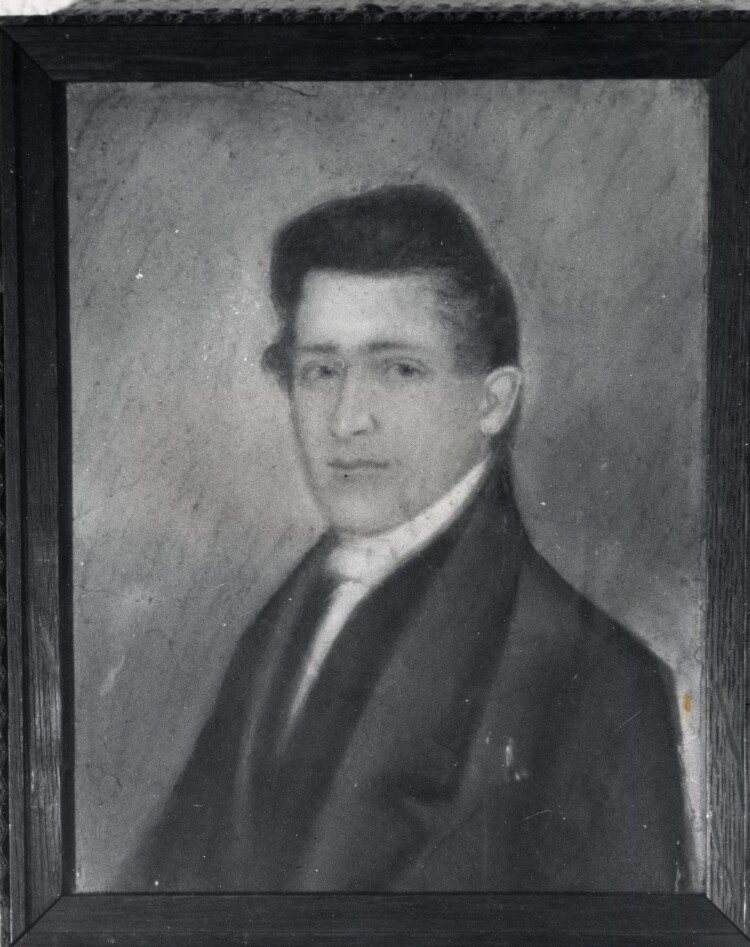John Anthony Gardner Davis became the Law School’s second professor at the young age of twenty-eight. A native of Middlesex County, Virginia, the president of his alma mater, the College of William and Mary, once described Davis as “likely to be the most distinguished man of his time, in Virginia.”[1] Davis was born into a slaveholding family. His father, Staige Davis, was reported to have owned 35 enslaved persons according to the 1810 U.S. Federal Census.[2] While a professor at the Law School, Davis reported in the 1830 U.S. Federal Census that he owned 17 enslaved persons.[3] These enslaved individuals may have lived and worked at Davis’ home, Lewis Farm, which was constructed in 1826 and located on a plantation.[4] In 1832, Davis and two other faculty members purchased Lewis Commodore, an enslaved man, for the University to work as bell ringer and general room attendant. Later that year, the Board of Visitors reimbursed the three faculty members for this purchase and resolved to hold Lewis Commodore as University property.
Davis was admitted to the bar in 1822. While practicing as a lawyer in Charlottesville, he enrolled in a science course at the university in 1825, becoming one of its first alumni. Davis also served as the secretary of the Board of Visitors prior to being elected professor of law. Like his predecessor, he advocated a strict interpretation of the Constitution, following that of Jefferson and Madison. He, too, saw the need for the study of the law to include a wide-ranging liberal education. Davis served as chairman of the faculty for five years and authored the widely used Treatise on Criminal Law, and Guide for Justices of the Peace, the first complete treatment of Virginia criminal law. He was the first of several law professors to reside in Pavilion X on the Lawn.
One of his key contributions to the curriculum of the School of Law was to divide it into a junior class and a senior class: the junior course included studies that “form an essential part of a liberal professional education” while the senior course was “exclusively occupied with the study of the theory and practice of the Law as a profession.” From student notes on Davis’ lectures, it is apparent that Davis believed slavery was too engrained in the country’s fabric to be eradicated and that enslaved people in Virginia were “more comfortable and happy than the lower classes of people, in any country.”[5]
The Law Society was created in 1833 under Davis’ instruction in order to train students in legal investigations, forensic debates, and the practical aspects of the legal profession. The Alumni Bulletin of the University of Virginia noted in 1895, “Characteristic of Professor Davis was the blended tact and benignity which marked his intercourse with his students, and that paternal interest he manifested, especially, but by no means exclusively, to those in his class. In sickness they were often removed to his house, and nourished with tenderest care. In their troubles, he was a sympathizing and judicious advisor.” In 1840, Davis stepped outside his pavilion on the East Lawn to investigate a disturbance and was shot and killed by a rioting student when he attempted to remove the student’s mask. The student body’s response to the murder of Davis contributed to the creation of the university’s honor system.[6]
[1] "John Anthony Gardner Davis," University of Virginia Arthur J. Morris Law Library, accessed 25 August 2020.
[2] 1810 United States Federal Census, Urbanna, Middlesex, Virginia, ancestry.com.
[3] 1830 United States Federal Census, Albemarle, Virginia, ancestry.com.
[4] "The Farm," Register of Historic Places Registration Nomination Form, Charlottesville, Virginia, September 3, 1996, accessed September 9, 2020.
[5] G. W. Blatterman Notebook, 1838-1839, page 67.
[6] "John Anthony Gardner Davis."
Sources
Books
Other
- A Lecture on the Constitutionality of Protecting Duties, Delivered in the University of Virginia (Cary & Watson, 1832)
- An Exposition of the Principles Which Distinguish Estates Tail from Other Limitations (Tompkins & Noel, 1837)
- The 1895 Alumni Bulletin (pg. 101-03) contains a tribute to Davis, which also covers certain aspects of his teaching.
- A member of his family wrote a biographical sketch of Davis and donated it to the Law Library.
- *This document incorrectly refers to the UVA law professor murdered by a student in 1840 as John Andrew Gardner Davis. His name is John Anthony Gardner Davis.

